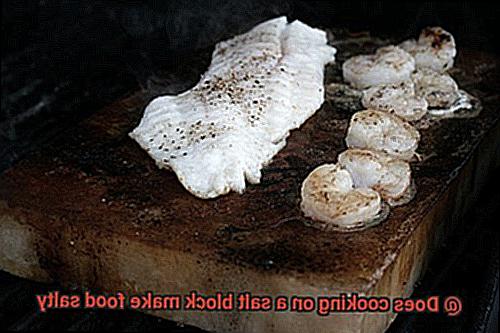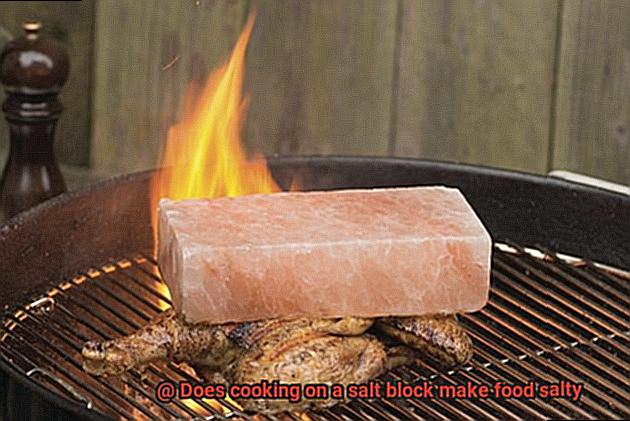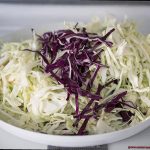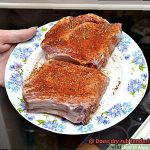Are you a culinary adventurer always on the lookout for the next big thing? If so, you’ve probably heard of the latest craze: cooking on a salt block. Not only is it visually stunning when serving up food, but it also claims to impart a distinctive flavor and texture to your dishes. But wait, won’t using a salt block make everything taste super salty?
Many people assume that cooking on a salt block will result in an overpowering salty taste. After all, it’s a colossal block of salt, right? However, this isn’t entirely accurate. When you cook on a salt block, the salt permeates the food, providing an understated yet unmistakable flavor while enhancing the natural taste of your ingredients. Moreover, the salt block can also create a unique texture in your dishes by adding a crispy and caramelized crust to meats and veggies.
In this blog post, we’ll dive deeper into the science behind cooking with a salt block and how it affects your food’s taste. We’ll examine the advantages and possible drawbacks of using such blocks as well as explore some mouth-watering recipes to experiment with your new culinary tool. So buckle up, fellow foodies- it’s time to spice things up and discover this thrilling trend.
Contents
Understanding the Basics of Cooking on a Salt Block

Cooking on a salt block has taken the grilling world by storm, with its unique flavor-enhancing properties and stunning presentation. But, is this cooking technique really worth the hype? And, will it make your food too salty? Let’s delve into the basics of cooking on a salt block.
First off, a salt block is a slab of pure Himalayan salt that can be heated and used as a cooking surface. When heated, the salt block retains its heat for a long time, making it an ideal surface for cooking food. As the food cooks on the salt block, it absorbs some of the salt from the block, which enhances its flavor profile. However, this doesn’t necessarily mean that the food will be excessively salty.
The amount of salt that gets absorbed by the food depends on various factors such as the type of food being cooked and how long it’s cooked for. Meats and seafood tend to absorb more salt than vegetables or fruits. Therefore, it’s crucial to keep an eye on your food while it cooks on the block and remove it at the right time to avoid over-salting.
For best results, it’s essential to heat the salt block gradually to prevent cracking. Once heated to the recommended temperature, place your food on the block and let it cook for the recommended time. Overcooking can cause your food to become excessively salty and ruin your meal.
It’s also important to note that not all salt blocks are created equal. Some blocks are more porous than others, which can lead to more salt being absorbed by the food. Hence, choosing a high-quality salt block is essential to ensure you get the perfect result every time you cook.
Apart from its flavor-enhancing properties, cooking on a salt block also adds a stunning presentation element to your dishes. The minerals in Himalayan salt create a unique pattern on your food, adding an elegant touch to your meals.
Does Cooking on a Salt Block Make Food Too Salty?
The answer to this question is not as straightforward as it seems and depends on several factors.
Firstly, the type of salt block you use plays a significant role in how salty your food becomes. Himalayan pink salt blocks are known for their subtle flavor and are less likely to make your food overly salty compared to other types of salt blocks. Therefore, if you are concerned about over-salting your food, opting for a Himalayan pink salt block may be your best bet.
Another crucial factor to consider when cooking on a salt block is how you use it. If you heat the block too quickly or use it at too high of a temperature, the food can become too salty. To avoid this, it’s crucial to follow proper heating and cooking instructions when using a salt block. Take your time and don’t rush the heating process.
Furthermore, the type of food you cook also affects the level of saltiness. Foods that are naturally salty, such as seafood or cured meats, may absorb more salt from the block than other foods. Therefore, when selecting foods to cook on a salt block, be mindful of their salt content.
In summary, cooking on a salt block can add a unique flavor and enhance the overall cooking experience. To avoid over-salting your food, consider using a Himalayan pink salt block, following proper heating and cooking instructions, and being mindful of the type of food you’re cooking. With these tips in mind, you’ll be able to create delicious and perfectly seasoned dishes every time.
Factors That Affect How Much Salt Transfers to Food
Well, the answer is not so simple. Let me guide you through the factors that affect how much salt transfers to your dish.
Firstly, the type of salt block you use can greatly impact the outcome. Himalayan salt blocks, crafted from pink salt mined from the Himalayan mountains, are a popular choice for their lower saltiness levels. Conversely, sea salt blocks tend to be saltier and may transfer more salt to your food. So choose wisely, depending on the desired level of saltiness.
But that’s not all – temperature also plays a crucial role in this game. If you heat your block too quickly or at too high of a temperature, it can cause the salt to dissolve and over-season your dish. To avoid this, take things slow and steady. Gradual heating at lower temperatures will result in less salt transfer and a more balanced flavor.
And last but not least, cooking time is an important factor to consider. Longer cooking times allow for more absorption of the salt into your food, resulting in a more pronounced salty flavor. On the other hand, shorter cooking times may not allow for enough salt transfer.
Proper Heating and Cooking Techniques for Salt Blocks
Look no further than cooking on a salt block. However, before diving in, it’s crucial to master the proper heating and cooking techniques to achieve the best flavor and results.
The first step is to ensure that your salt block is heated correctly. Start by using a low heat and gradually increase the temperature to prevent cracking or breaking. Allow the salt block to heat for at least an hour before cooking on it.
Prevent sticking by applying a thin layer of oil on the surface of the block. This not only keeps your food from sticking but also helps regulate the amount of salt absorbed by your food, preventing it from becoming overly salty.
While cooking, monitor the temperature of the salt block regularly. Overheating can cause the block to crack or break, so use a meat thermometer to check the surface temperature of the block.
When choosing foods to cook on a salt block, opt for those that can withstand higher temperatures and absorb some of the salt flavor without becoming too salty. Consider steak, seafood, and vegetables as excellent options.
The Unique Flavor Profile Created by Cooking on a Salt Block
If you’re looking to elevate your cooking game and impress your guests, then cooking on a salt block might be the perfect addition to your culinary repertoire. Not only does it add a touch of elegance to your cooking, but it also creates a unique and mouth-watering flavor profile that you won’t find anywhere else.
So what’s the secret behind the salt block’s flavor profile? First and foremost, it all starts with the way that the salt block is heated. This slow and gradual process allows the block to absorb moisture from the air, which in turn creates a natural seasoning that enhances the flavor of your food. The result is a subtle and savory taste that can’t be replicated with any other cooking method.
As your food cooks on the surface of the block, it absorbs some of the salt, which gives it an extra layer of flavor. However, this doesn’t mean that your food will be overly salty. In fact, the amount of salt absorbed depends on several factors, including thickness and cook time. This means you have full control over the level of saltiness in your dish.
Another key factor that contributes to the unique flavor profile created by cooking on a salt block is the even distribution of heat. Because the block retains heat evenly, your food will cook more thoroughly and come out juicier and more flavorful than it would on a traditional grill or stove. No more unevenly cooked meats or dried-out veggies.
Of course, there are some things to keep in mind when using a salt block. For example, you’ll want to avoid using oils or marinades, as these can cause flare-ups and potentially damage the block. Instead, try seasoning with herbs or spices to enhance the natural flavors of your food. And be sure to heat the block gradually to avoid any cracking or damage.
Tips for Avoiding Overly Salty Dishes
Cooking on a salt block is a trendy way to add a new dimension of flavor to your dishes, but sometimes it can be easy to overdo it on the saltiness. Luckily, there are some tips and tricks you can follow to ensure that your food is perfectly seasoned every time.
Opt for a thicker salt block
The thickness of the block can impact the amount of salt that is released into your food. A thicker block will release less salt, resulting in a subtler flavor.
Use the salt block as a cooking surface
Instead of using the block as a seasoning tool, place raw ingredients directly onto the block and let them absorb some of the salt as they cook. This will create a more nuanced flavor compared to using the block solely as a seasoning tool.
Be mindful of your overall salt usage
Remember that the salt block will add some level of saltiness to your dish, so it’s important to adjust your seasoning accordingly. Use less salt than you normally would when cooking on a regular surface.
Experiment with different cooking techniques
The type of cooking method can also impact the level of saltiness in your dish. Grilling or searing on high heat will result in a stronger salt flavor compared to lower heat methods like roasting or baking.
Remedies for an overly salty dish
If you find that your dish has become too salty, there are some steps you can take to remedy the situation. Adding more acid like lemon juice or vinegar can help balance out the saltiness, while adding more unsalted ingredients or serving with a non-salty side can help dilute the flavor.
What Foods are Best Suited for Cooking on a Salt Block?
If you’re looking for a new and exciting way to cook, using a salt block might just be the answer. However, not all foods are created equal when it comes to cooking on a salt block. As an expert in this field, I’ve compiled a list of the best foods to cook on a salt block to help you achieve culinary perfection.
First and foremost, seafood is a natural choice for cooking on a salt block. Shrimp, scallops, and fish are excellent options that benefit from the unique flavor that the salt block imparts. The salt helps to enhance the natural sweetness of the seafood while also adding a subtle salty flavor. Additionally, the high heat of the salt block sears these proteins quickly, resulting in a crispy exterior and tender interior.
Vegetables are also well-suited for cooking on a salt block. Asparagus, zucchini, and bell peppers are just a few examples of vegetables that work well on a salt block. When cooked on a salt block, they retain their natural flavors and textures while taking on a slight salty taste. Plus, the caramelization that occurs gives them a delicious smoky flavor that’s sure to impress your dinner guests.
While meats can be cooked on a salt block as well, they require more care and attention than seafood and vegetables. Lean meats like chicken breast or pork tenderloin can dry out quickly when cooked on a salt block. It’s important to marinate them beforehand and cook them at a lower temperature to ensure that they stay moist and tender. On the other hand, fatty meats like steak or lamb chops work better because the fat helps to keep them moist during cooking. These proteins benefit from the high heat of the salt block which sears them quickly, creating a crispy exterior while locking in the juices.
Overall, any food that can be grilled or seared is suitable for cooking on a salt block. However, it’s important to keep in mind that the salt block will add a subtle salty flavor to the food. So if you’re cooking something that is already naturally salty, like bacon or ham, you may want to avoid using a salt block.
Common Mistakes to Avoid When Using a Salt Block
Using a salt block can undoubtedly take your cooking skills to the next level, but like any cooking method, there are common mistakes to avoid. These errors can impact not only the taste of your dishes but also the lifespan of your beloved salt block. So, let’s dive into some of the most common mistakes to avoid when using a salt block.
First and foremost, ensure that you preheat your salt block correctly. Proper preheating is essential to ensure even cooking and prevent an overly salty taste. It is recommended that you preheat your salt block slowly over low heat for at least 30 minutes before using it for cooking. This step will ensure that your food is cooked evenly, and the flavors are enhanced without being too salty.
Secondly, don’t overdo it with the salt. Remember that salt blocks are naturally salty, so adding additional salt can ruin your dish and make it overpoweringly salty. It is suggested that you use less salt than usual when cooking on a salt block to avoid an excessively salty taste.
Thirdly, don’t forget to clean your salt block thoroughly after use. Leaving food particles on the salt block can lead to bacterial buildup and health issues. It is recommended that you clean the salt block with a damp cloth or sponge without using soap or other detergents.
Lastly, handle your salt block with care and avoid dropping or placing it on uneven surfaces. Salt blocks are delicate and prone to breaking if mishandled. If a salt block does break, it should be disposed of properly.
tp7mVn2qZSU” >
Conclusion
In conclusion, cooking on a salt block is an innovative and exhilarating way to elevate the taste of your meals. Contrary to popular belief, using a salt block doesn’t necessarily make your food overwhelmingly salty. Instead, the natural flavors of your ingredients are enhanced by the subtle infusion of salt.
To achieve optimal results, it’s crucial to select a top-quality salt block, gradually heat it up and follow proper heating and cooking instructions. Additionally, being mindful of the type of food you’re preparing can also impact the level of saltiness in your dish.
Not only does cooking on a salt block provide an exceptional flavor profile, but it also adds an impressive visual element to your meals. However, it’s important to avoid common mistakes such as improper preheating, excessive use of salt and inadequate cleaning after use.






